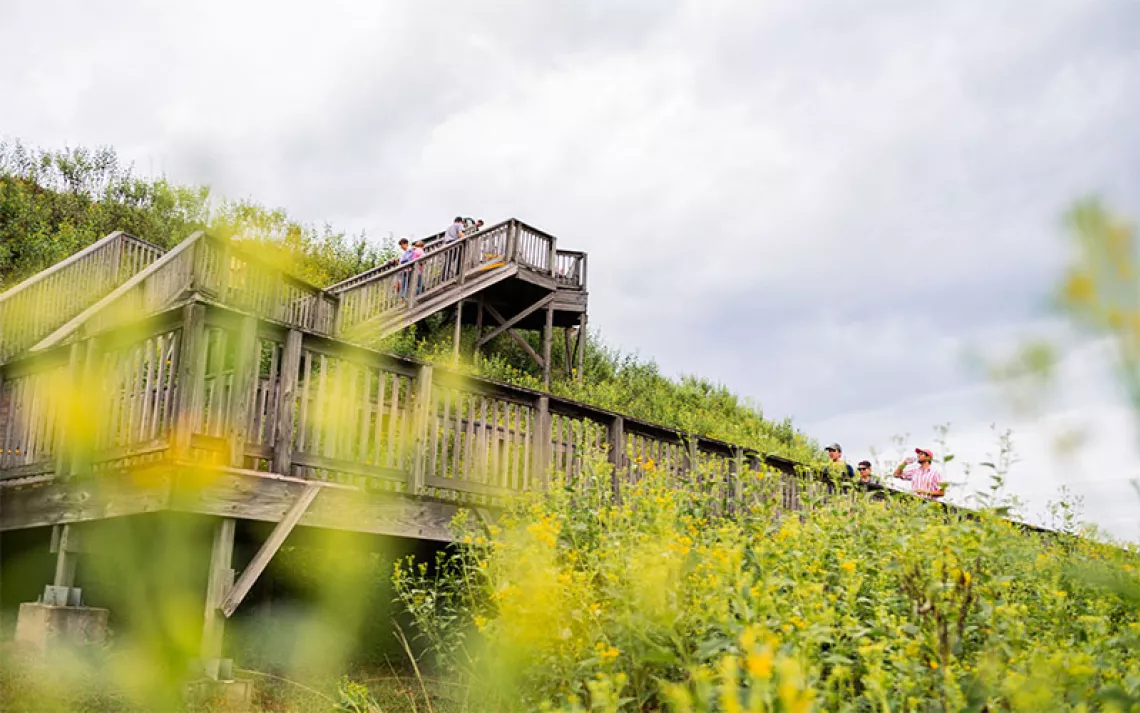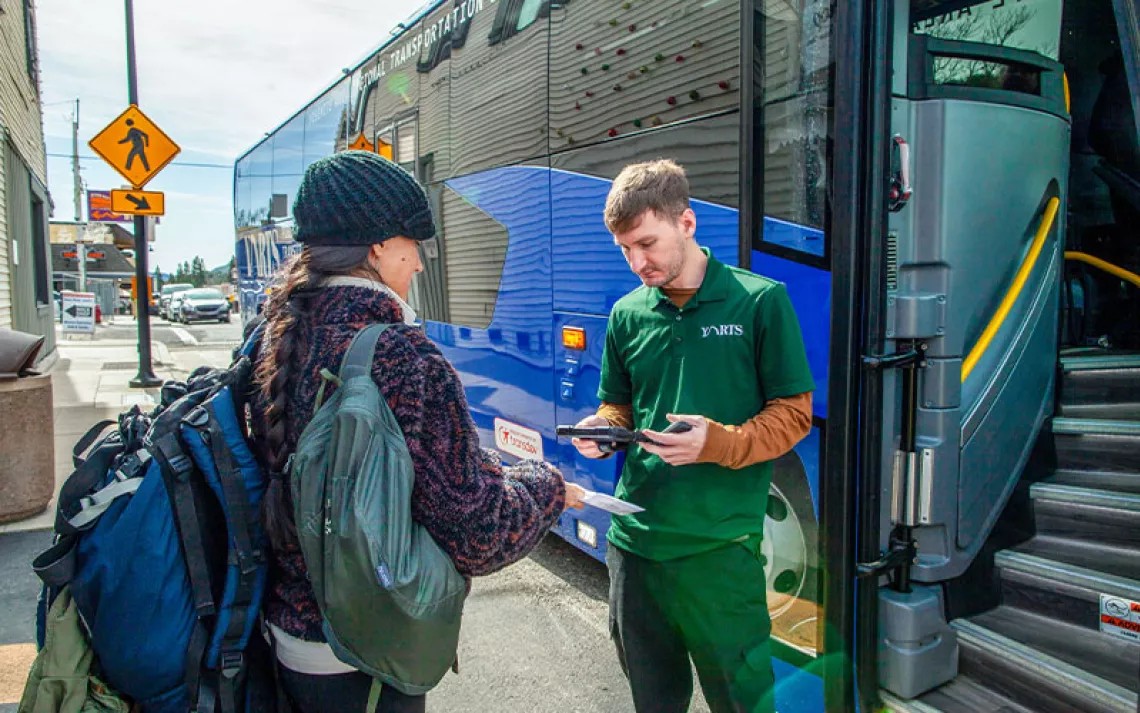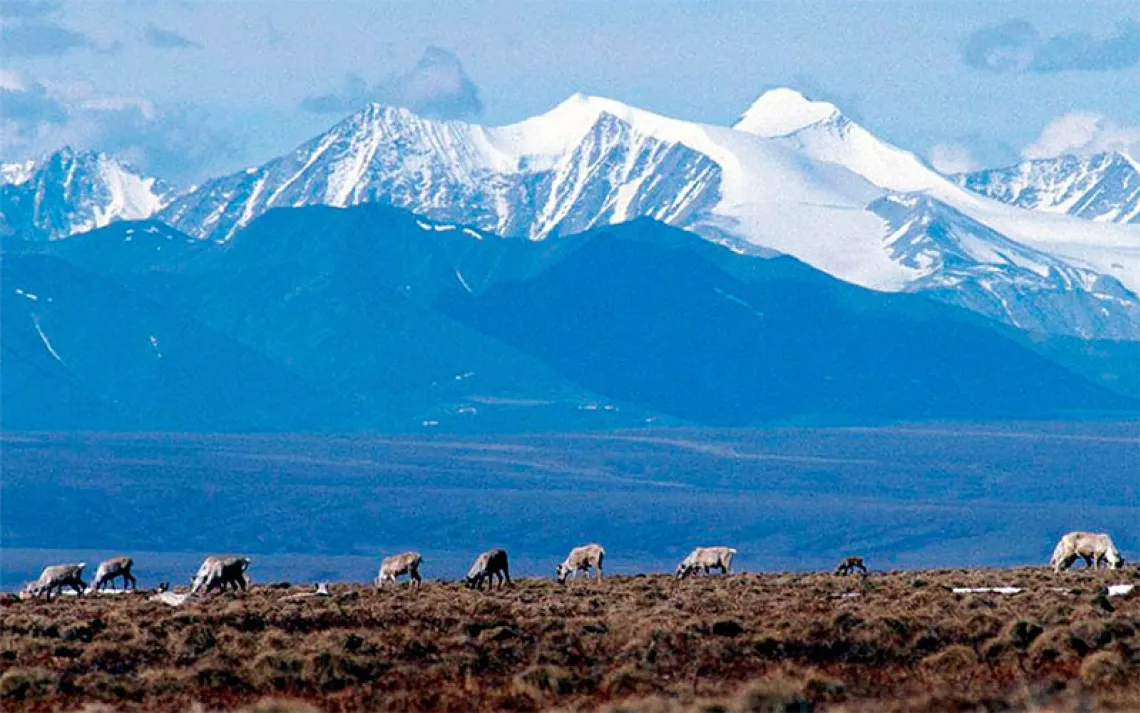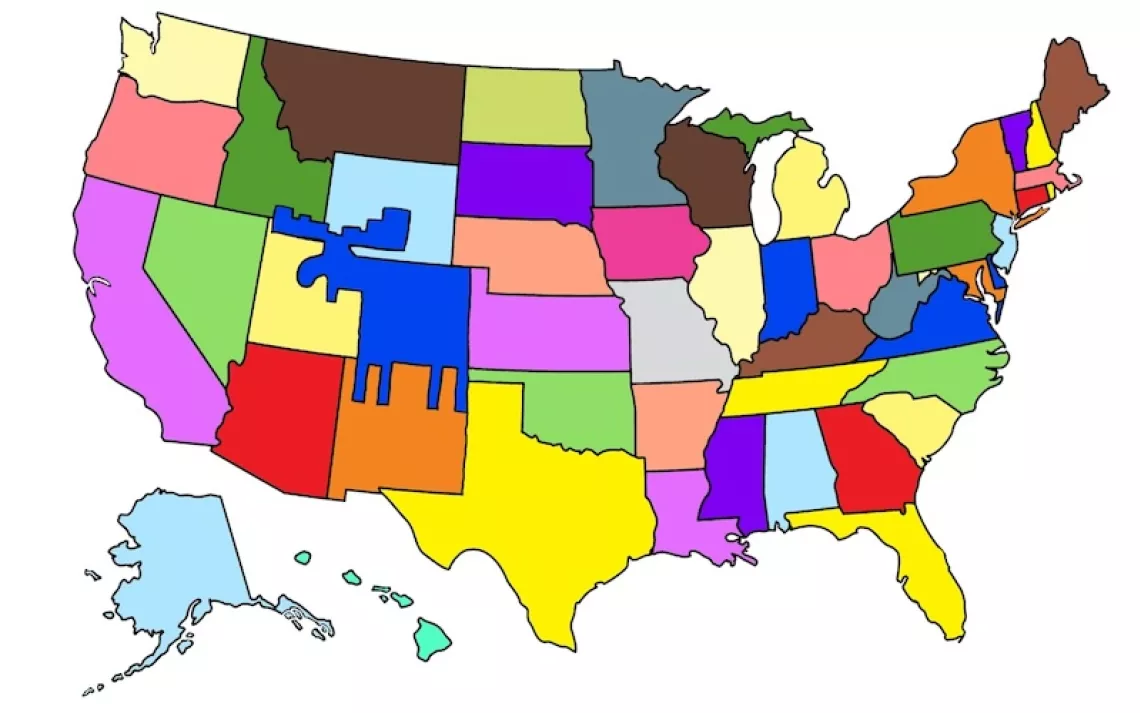Are Social Media Videos Ruining the National Park Experience?
Influencers are broadcasting their park experiences to tens of thousands of followers. But at what cost?
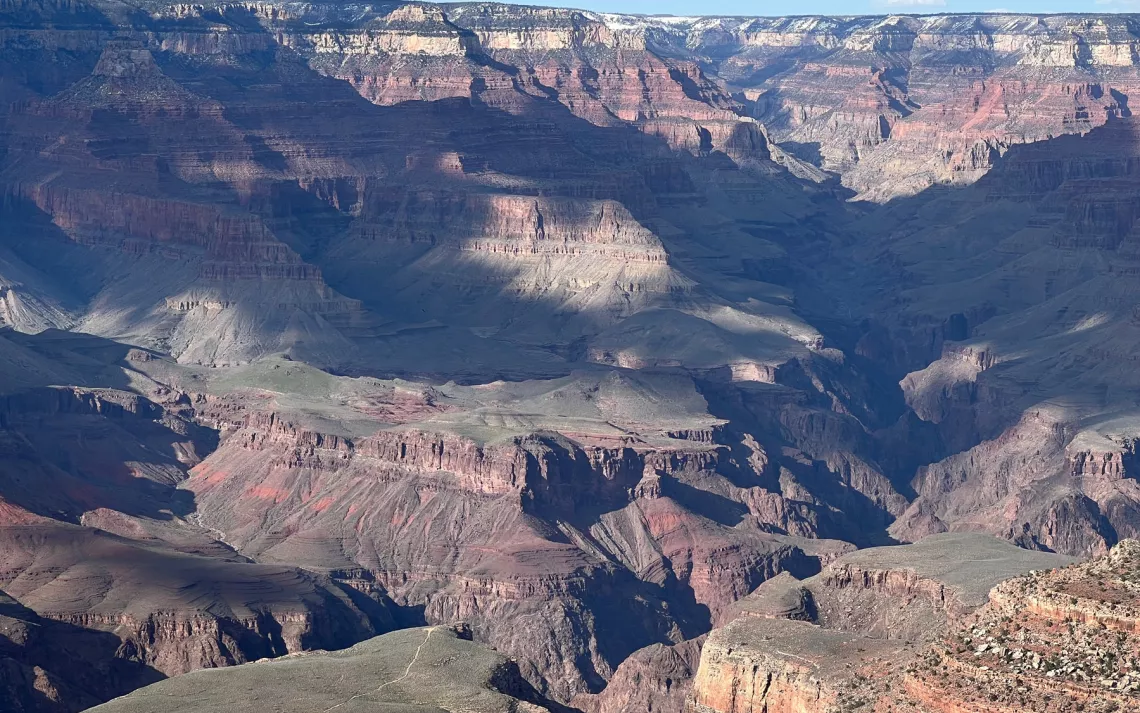
Cloudy with a chance of golf balls (Grand Canyon National Park). | Photo by Geoff McGhee
Below Mather Point, one of the most accessible outlooks at Grand Canyon National Park’s South Rim, lie curving layers of 200 million-year-old sedimentary stone, and the Colorado River, which helped carve them. Also below Mather point? A golf ball and 20-year-old Katie Sigmond’s driving club.
In October 2022, the social media influencer recorded herself hitting a golf ball into the abyss, using the canyon’s cathedral-like walls of exposed rock as a backdrop to entertain her 7 million TikTok followers, promote her brand, and leave her own mark. “I was thinking in my head…‘I can make golf content. Like, it’s such a pretty view. Let me just golf into the Grand Canyon,’ Sigmond told fellow influencer Aaron “Steiny” Steinberg in a podcast interview.
“Dumbest idea.”
“America's best idea” meets a visitors’s “dumbest idea” Grand Canyon National Park administration reacts to the golf stunt at Mather Point. Facebook
Some of her followers immediately reported her to the park. Three federal violation notices and a $285 fine followed. (Sigmond did not reply to multiple requests for comment.) With this, Sigmond joined a growing list of influencers—including comedian Jake Adams, who lobbed biodegradable golf balls into Yellowstone National Park— using parks as their social-media playgrounds.
The union of national parks and social media was inevitable. For an internet audience seeking novelty and the breathtaking scenery of national parks, social media has been both exhilarating and troubling. In recent years, there have been a rising number of reports of social media promotions prompting hikers to take inappropriate and dangerous videos that threaten wildlife, the environment—and themselves. In 2018, two Instagram travel bloggers fell to their deaths at Yosemite National Park after setting up a camera for a selfie.
Cassie Yahnian and Danielle LaRock host the popular podcast “National Park After Dark,” which recounts misadventures in the park system. They believe that many visitors expect that national parks are a controlled environment when in reality they are some of the only “true wild places” left. LaRock cited social media as a huge driving factor for this false sense of security.
In recent years, there have been a rising number of reports of social media promotions prompting hikers to take inappropriate and dangerous videos that threaten wildlife, the environment—and themselves.
Then there are those who use scenic federal lands to do something outrageous. In 2020, a 35-year-old skier, David Lesh, wanted to hike on camera. Against the backdrop of multiple “closed” signs, he hiked up Forest Service land to Colorado’s Hanging Lake, shrugged off his shirt, casually stepped over a sign saying “No Walking on Log,” and struck a pose, standing on the log and gazing pensively at the water.
A few days later, another photo of Lesh, apparently pooping on federal Forest Service land near Maroon Bells Lake, went viral on Instagram. In a 2021 New Yorker piece, “Trolling the Great Outdoors,” Lesh claimed both images were photoshopped. US District Court Judge Gordon P. Gallagher banned Lesh from Forest Service land and prohibited him from posting on social media images of anyone violating the law on federal lands.
Parks see record traffic as social media users heed call of the wild
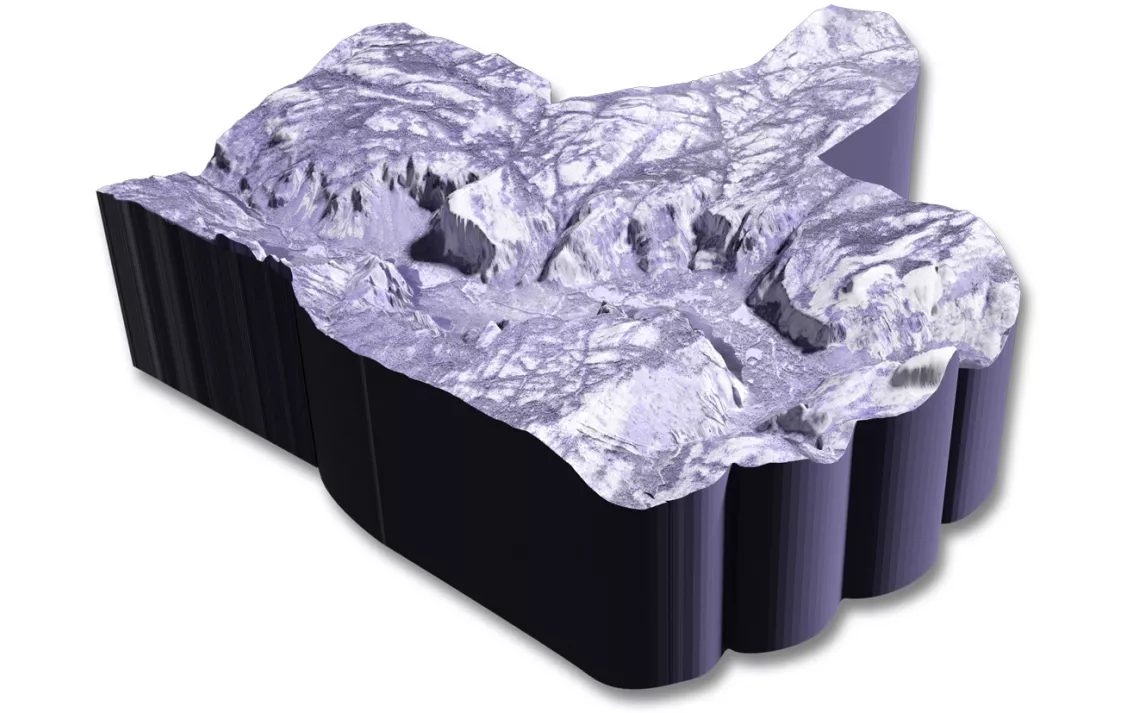
Geoff McGhee
Park managers have a choice: either subscribe to the benefit of social media to attract and inform visitors or focus on curtailing its role in promoting excessive crowding of popular sites and incentivizing daredevil behavior.
Still, for every Katie Sigmond, David Lesh, or other careless selfie-seeker, there are outdoor lovers seeking to proselytize about public lands’ wonders and entice visitors who have been indifferent to parks or felt excluded from them, like people with disabilities or people of color. Influencers such as Arizona Hikeaholics can have a positive impact, promoting outdoor ethics and filling in information gaps.
After 19 years working at national parks, Matthew Turner, who manages social media platforms for the National Park Service, is optimistic. “We’re always looking for ways to use the technology to reach new audiences and make sure that we are accessible,” he said. Turner revolutionized the social media presence of the 107-year-old federal agency, which now has more than five million followers on Instagram. But even he acknowledges that the agency is still learning to navigate an ever-changing social-media space.
“Everybody should get a chance to see the parks because not everybody's gonna go to our website and not everybody's gonna get to Yellowstone in their lifetime”
In 2022, social media usage spiked by 20 percent, and it has continued to hover around that level ever since. Over the previous 12 years, the number of national park visitors increased more than 25 percent, going from about 70 million to about 90 million visitors annually. According to new research from Cornell University, parks with high positive social media exposure saw visitation increase by 16 to 22 percent compared to parks with less positive exposure. More visitors mean more income.
Shared videos on social media, or virtual reality experiences by Meta Quest, a division of Meta—the company that owns Instagram and Facebook—bring the park experience to those unable to come in person. “Everybody should get a chance to see the parks because not everybody's gonna go to our website and not everybody's gonna get to Yellowstone in their lifetime,” Turner said.
Park rules sought to head off trouble, but some resented “red tape”
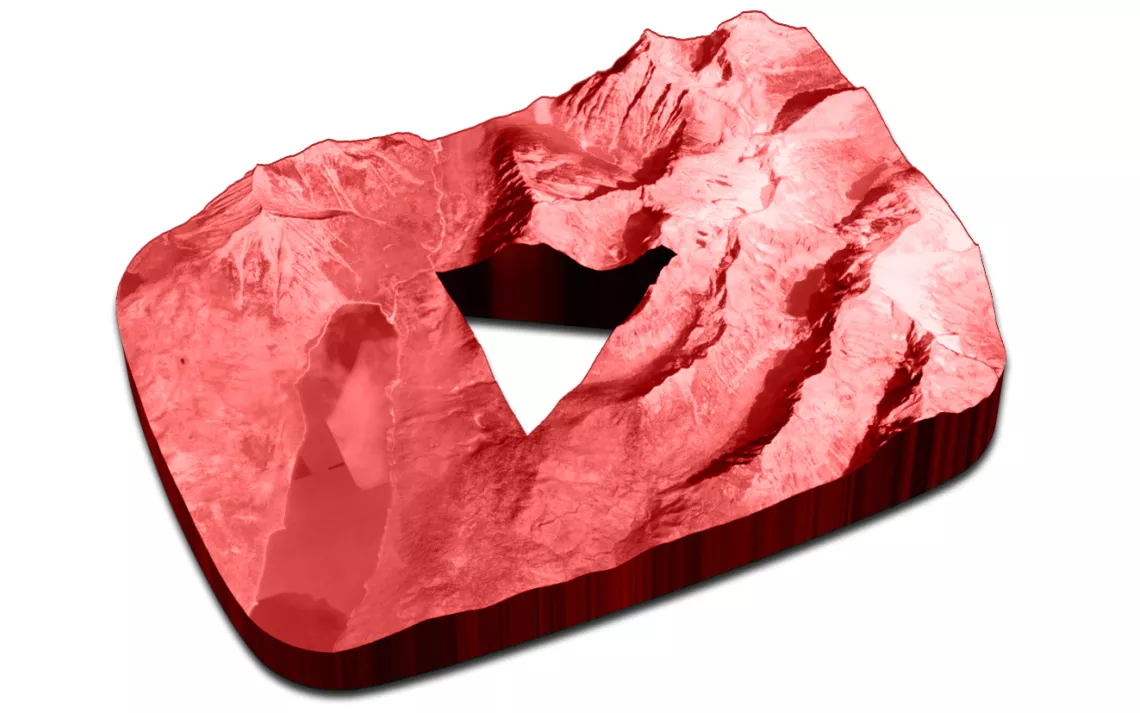
Geoff McGhee
Over the past decade park managers and park supporters have been fascinated and disturbed by how social media is changing the national park experience. The National Parks Service social media policies, last updated in July 2022, state, “Be mindful of what your images portray. Do not promote illegal or unsafe behavior.” In 2017, Instagram released guidelines on protecting wildlife and nature. These guidelines, however, don’t address things like geotagging and social media use disrupting others’ experiences.
In 2017, outdoor photographer Elisabeth Brentano posed an important question: Has anyone in the park service asked social media companies to limit reckless, unethical outdoor content? In 2019 she launched a petition, calling for Instagram and Facebook to “implement a system allowing users to report violations that are both illegal and harmful to the environment.”
Since then, some worrisome trends have accelerated. “Given social media and how it’s changed and evolved in a very quick period of time, we are seeing quite a few social media influencers that have a huge reach in terms of their impact. Filming is very minimal: two people with just their cell phones. But they do have a wide, wide reach,” said Joelle Baird, who runs social media at Grand Canyon National Park.
One lever the park service has had is a pre-existing system of film permits, which was created to control the potentially intrusive work of documentary filmmakers and television advertisers. But, Baird said, there’s a vast difference between the old days of filming and the era of camera phones. Enforcing permits for recreational videographers has been problematic.
A federal law, enacted in 2000, mandated that the Forest Service and Interior agencies like the National Park Service require permits and set fees for commercial filming and certain still photography. Commercial filming was defined as video that could generate income. When the Park Service applied this law to cell-phone users and influencers, objections came fast. In filling out the park-specific filming permit application, Ritchie Roesch said, he encountered a process set up for a big-time cinematic production. “My visit would have been 100 percent identical if my channel was or was not monetized, or if I even had a YouTube account or not,” Roesch wrote in a Fuji X Weekly blog post after going through the “frustrating” permit process.
His was one of a swath of negative reactions. Kara and Nate Buchanan (@karaandnate), popular YouTubers and travel bloggers, filmed in Rocky Mountain National Park and Great Sand Dunes National Park in 2020 without a permit. The National Park Service levied more than $1,000 in fines and banned them from filming in national parks without a permit; days later, the influencers shared their decision to avoid national parks altogether.
Joelle Baird, at Grand Canyon National Park, recognized that most visitors are posting content on social media without a permit. “Commercial filming activity is very behind the scenes and more or less goes unnoticed compared to a lot of other things happening here at the park,” she acknowledged, nodding to the park’s chronic understaffing. “From a staff perspective, permit monitors and filming monitors function as a frontline filter to minimize the impact of these types of activities.’”
This unpopular permit system has been through a legal roller-coaster ride now nearing its end. In January, 2021, a federal district court blocked the permitting rule. In August of 2022, a circuit court reversed the decision. Jason Epperson, host of RV Miles and America’s National Parks, a podcast, is one of many who have refused to get permits. “I’m not going to be doing anything to disrupt anybody’s experience.”
This year Congress stepped in. In early April, the House of Representatives approved a bill— called the Expanding Public Lands Outdoor Recreation Experiences (EXPLORE) Act—that will relax filming permit restrictions and forbid fees and permits for filming or photographing activities with minimal impact on federal lands. Senate approval is expected soon.
The one platform where the park service has no account is TikTok; posting on the Chinese-owned service by government agencies is forbidden. TikTok, which hit American app stores in 2017 and boomed in popularity in 2020, is the target of increasing official scrutiny. But the absence of park-service commentary is hardly noticeable, as many others use TikTok to show off the parks they love—or, like Sigmond, to vandalize them for self-promotion.
A national survey by the tourist marketing agency MGH found that 35 percent of US TikTok users— approximately 52.5 million people—have traveled to a new destination, including national parks, after seeing a TikTok video about it. TikTok is particularly influential for the millennial generation, the survey found. Forty-five percent of millennials surveyed have traveled to a new destination they saw on TikTok.
Social media opens new windows on parks for disabled and historically marginalized groups
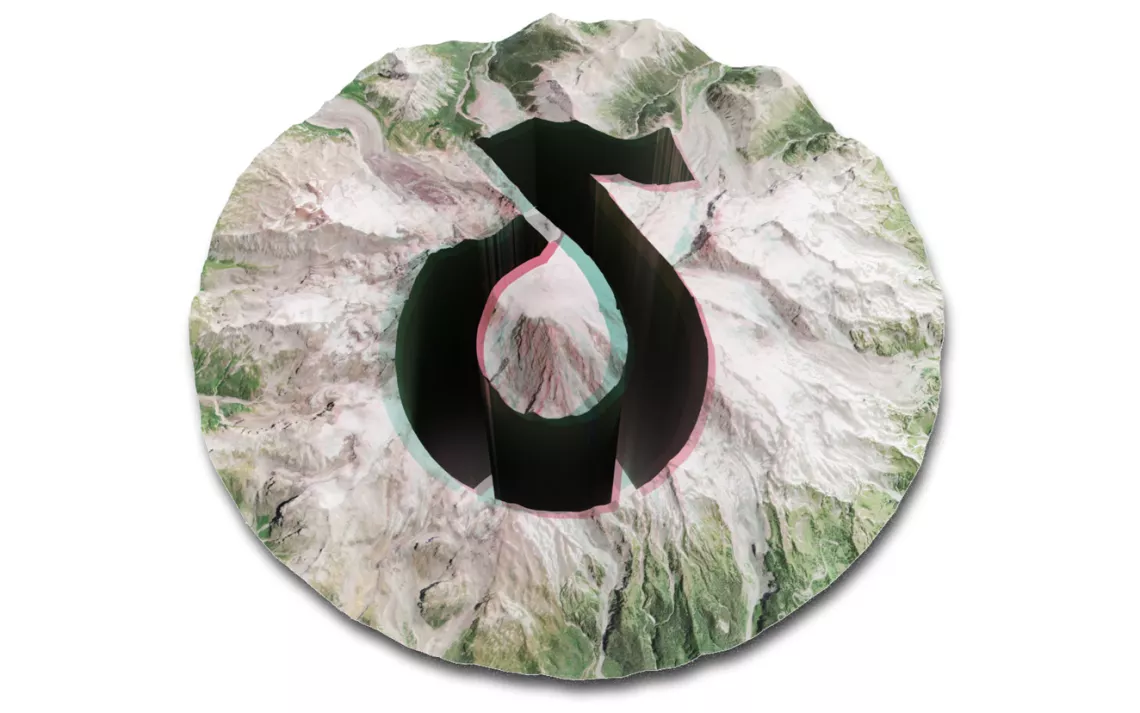
Geoff McGhee
An unspoken conversation occurs between Diamonique Clark and Kristen Walker, two Black women, as they pass through towns on their way to hiking at national parks. “We recognize that we don’t look like the people that live there,” Clark said. “And we could potentially be in some uncomfortable situations.” Co-founders of Our Parks Too!—a Black outdoor and environmentalist project supported by the Sierra Club and Soul Trak Outdoors—the two women are part of a growing social-media movement making space for underrepresented communities to advocate for park landscapes.
Clark says it’s commonplace for outdoor social platforms to hype other platforms. Seeing her posts inspired a former classmate to purchase binoculars to support a lifetime of birding. “We get DMs all the time, saying how inspirational it is to see two Black women from the city being outside and being ourselves,” she said.
The underrepresentation of diverse communities in outdoor recreation, often called the “green ceiling” or "adventure gap" has gained significant attention: A conversation intensified among industry leaders and outdoor enthusiasts following the racial justice protests of 2020. KangJae “Jerry” Lee, an assistant professor at North Carolina State University specializing in race and outdoor leisure, said, “Connecting the dots reveals that people of color have been systematically excluded from outdoor experiences.”
“Wilderness, wildlife, wonder…the more people know about the park the more they are going to feel invested in its future.”
Some park promoters seek to revive the histories of lesser-known Black historic figures like Charles Young and the predominantly Black Buffalo Soldiers, who did significant work in protecting the nascent parks a century ago, as well as Black members of the Civilian Conservation Corps, who built and renovated many state and national parks during the Depression—when they weren’t legally allowed to visit them.
For those physically unable to access park spaces, social media sites fill in information gaps on accessible activities. Alvaro Silberstein (@alvasil), a 36-year-old C5-6 quadriplegic who founded Wheel the World—customized trip planning for travelers with disabilities—donated special trekking wheelchairs to the park service.
Social media can keep parks politically relevant. “Wilderness, wildlife, wonder…the more people know about the park the more they are going to feel invested in its future,” said Doug Mitchell, Executive Director of the Glacier Park Conservancy.
Managing parks for conservation or visitation?
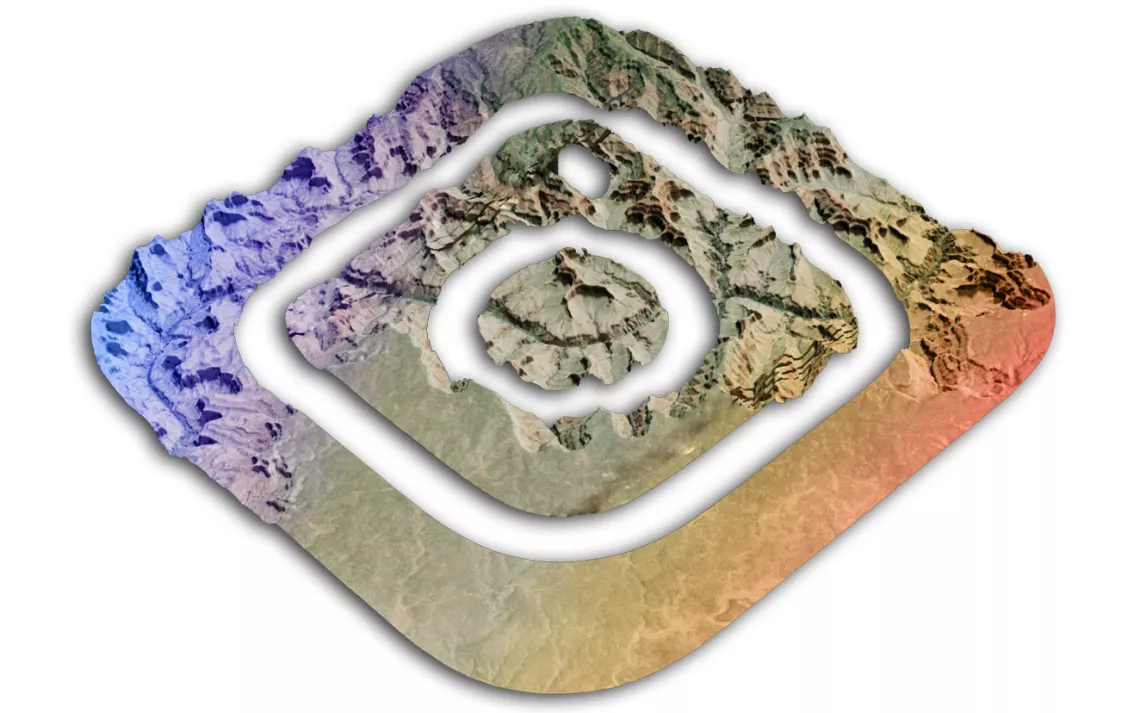
Geoff McGhee
Decades ago, the National Park Service paid photographers like Ansel Adams to promote its vistas. Matthew Turner’s job is different. Since he took charge of the Park Service’s online accounts he says, “we want to use social media to be a part of the conversation.” Among other things, park accounts can warn of hazards like floods. But those are practical warnings and don’t shape visitors’ expectations.
“Visitor expectations aren’t part of the Park Service mandate,” said Jeff Ruch, Pacific Director of PEER. “If they say they’re managing and providing facilities to meet those expectations then you’re on a slippery slope to Disneyland.” Ruch represents an environmental advocacy organization, founded by public employees, that has spent years opposing such National Park Service ambitions as expanding cell tower construction.
Others have a different reading of the 1916 Organic Act that established the park service, pointing out the language instructing the service to “promote and regulate the use of parks … to conserve the scenery.. And to provide for the enjoyment of same…”
National Parks are highly visible elements shaping national identity: there is constant pressure to create new ones. Since 2018, when Turner took charge, the NPS federal accounts have themselves become influencers. Turner says that social media has become a tool to share the parks’ stories and a way to stay relevant.
Some users are questioning whether social media companies themselves can do more to protect national parks from the harm of irresponsible content. But Turner, the park service’s social media guru, isn’t sure what more can be done. “We get tagged in a lot of vandalism-related issues…or it’s something that’s not within our jurisdiction,” he said. “So then it’s like, well, what do we do with this? Who do we contact or who do we inform?” He agrees that when activities jeopardize park resources, social media companies can help alert the relevant authorities.
J.D. Tanner, who works as director of education and training at Leave No Trace, believes that people can be led to internalize respect for the land: he says a focus on “authority of the resource,” an education-first approach popularized by George Wallace, an emeritus professor at Colorado State University, is paying off across park landscapes. The group released a social media guide that urges visitors to avoid naming and shaming, instead using social media to promote leave-no-trace principles.
The negative impact of social media on arresting landscapes has come clear to at least one influencer. On a recent weekend, Kristen Walker of Our Parks Too! visited a popular waterfall in the Great Smoky Mountains National Park. She said it was the most crowded place she had ever visited. Walker watched as crowds inched closer to the falls, snapping photos and filming videos. “There was a sign that said ‘Please do not leave the trail. Danger of falling and being killed,’” she said. “There were people climbing down, over and around the sign, to get a closer video with the waterfall.”
It heightened her awareness of the ability of social media to exacerbate reckless behavior. “When we tag [the location in a social media post], we make sure to tag the park or tag the city, rather than the specific site or waterfall. I don’t think we’ve had detrimental impacts on parks by causing swells of people to come to a certain area where they could be messing stuff up,” she said.
 The Magazine of The Sierra Club
The Magazine of The Sierra Club












